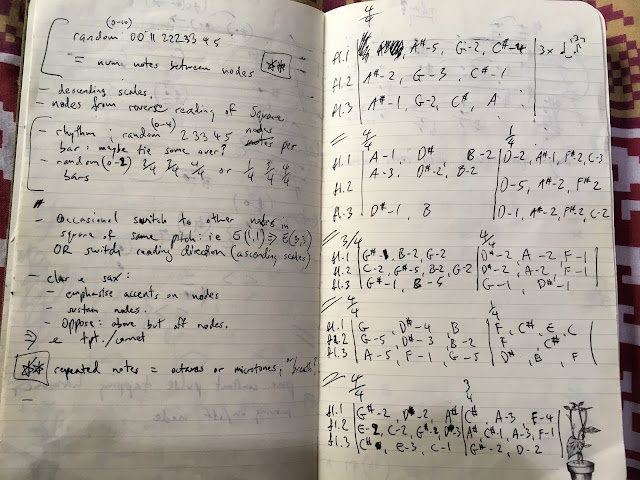This section has no solos, it's a simple contrast of two strata: (1) descending rapid scales, and (2) sustained chords swelling and receding. Listen to the opening page (score below) here:
 |
| Ex.1: score p.1 |
The pitches for both are derived from the magic square. The chords are most straightforward, they simply read the horizontals of the square as 6-note chords. The piece starts with the uppermost vertical (the main material + high G), and works its way down.
| E | G# | D | F# | A# | G |
| B | F | A | C# | A# | D |
| G# | C | E | C# | F | B |
| D# | G | F | A | D# | G |
| B | G# | C | F# | A# | D |
| B | D# | A | C# | F | A# |
Ex.2: magic square, showing different transposed 5-note sequences (alternating red and blue)
Here are the voicings; which I just worked on the piano intuitively by starting with the horizontal as written, then moving notes around to form triads where possible. Note also that I opted for a smoother orchestration across the three woodwind and three brass by dividing the 6-notes into two sets (reeds vs brass) that are often triadic, or nearly so in most cases.
 | |
|
 |
| Ex.4: "magic square with "roots" sustained; emphasising the harmonic basis of the square. |
The other stratum is descending scales, here on the three flutes as one group, and guitar/piano as the other. The guitar/piano lines are arpeggiated versions of the sustained chords, but reading from the bottom of the square up rather than top down. Originally these were supposed to be completely free-time, but I simplified this to molto rubato. The balance is not great here, as the guitar/piano are often only audible between ensemble chords.
The flutes part was significantly more complex (and took ages...) Essentially, the flutes all read the square the same way—backwards from bottom right—but each flute both places those pitches differently, and subdivides the intervening time and pitch spaces independently. Each interval between successive notes on the square is then subdivided, which may result in microtones. I used a max patch to generate the following, bar-by-bar:
- [numNodes] The number of "nodes" in this bar. That's the number of notes from the magic square sequence used in that phrase; also defining the position of these in the bar (i.e. four nodes with a 3/4 bar = dotted quaver each).
- this means that each instrument moves through the square at a slightly different rate, (forming momentary canons, though not really audible due to the rest of the process) but always averaging out across the full section.
- Also, because there's only a few possible values here, there's a good chance that these notes will line-up across the three flutes, accenting the harmony of the square, and relegating the extra subdividing notes as more of a distorting background harmony.
- [numNotes] the number of notes between each of the nodes above. I did my best to evenly subdivide the intervals (in terms of pitch as well as duration) to avoid overly complex notation. Microtones were avoided in fast runs (not perceivable), and nested tuplets avoided.
- Ex.5 below shows the patch and some of its output. For each bar it generates a number of nodes that subdivide the bar, then subdivisions for each of those nodes.
 |
| Ex.5: Max patch (and its output on right) generating each flute's path through the square. |
 |
| Ex.6: showing (left) original thoughts for the system, and (right) the specific realisation of each bar (from b.1) |
The structure of these sections is partially driven by the materiality of the flutes. When the descending line reaches the bottom of their register, it starts again from the top: the whole group goes back up together if any of them reach the bottom, so they sound as a disjointed group rather than coming apart completely. Although notated as fff throughout, this dynamic cannot be maintained in the low register, and the lower notes are often submerged under the sustained chords (intentionally).
The structuring principle of this section is is repetition followed by a slight inversion/change. I repeat this opening strata several times while the sustained chords work their way through the full square. Then at b.22 the material is slightly changed to destabilise the pattern. The flutes abandon the scales in favour of sustained multiphonics, but because these are unstable, the pitches move in and out of focus, leading to a disjoined soundworld that isn't a total change from the scales: an etiolated version for sure (see Ligeti's organ work Volumina for a similar concept). The guitar/piano come more to the fore here, briefly, before the wind chords take over.
Commentary notes:
- The magic square is the core of the harmony throughout: and since the square is made of the same 5-note chord transposed, this section is a multiple of a multiple, an almost fractal quality. The square's pitches are slightly emphasised in the flutes by accenting them. The two different materials (scales and chords) are simplistically opposed to each other in terms of texture, but they use the same basic pitch material. The scales have the additional distortion of the interwoven pitches between them.
- The readings of the square are quite simplistic, but then overlaid in a kaleidoscopic way, and with further distortion by the randomising process of the Max patch.

Comments
Post a Comment